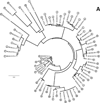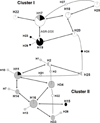Molecular epidemiology and genomics of group A Streptococcus
- PMID: 25460818
- PMCID: PMC4416080
- DOI: 10.1016/j.meegid.2014.10.011
Molecular epidemiology and genomics of group A Streptococcus
Abstract
Streptococcus pyogenes (group A Streptococcus; GAS) is a strict human pathogen with a very high prevalence worldwide. This review highlights the genetic organization of the species and the important ecological considerations that impact its evolution. Recent advances are presented on the topics of molecular epidemiology, population biology, molecular basis for genetic change, genome structure and genetic flux, phylogenomics and closely related streptococcal species, and the long- and short-term evolution of GAS. The application of whole genome sequence data to addressing key biological questions is discussed.
Keywords: Epidemiology; Evolution; Genomics; Group A Streptococcus; Population biology; Streptococcus pyogenes.
Copyright © 2014 Elsevier B.V. All rights reserved.
Figures







References
-
- Aanensen DM. London: Imperial College; 2014. http://spyogenes.mlst.net.
-
- Ahmad Y, Gertz RE, Jr, Li Z, Sakota V, Broyles LN, Van Beneden C, Facklam R, Shewmaker PL, Reingold A, Farley MM, Beall BW. Genetic relationships deduced from emm and multilocus sequence typing of invasive Streptococcus dysgalactiae subsp. equisimilis and S. canis recovered from isolates collected in the United States. Journal of clinical microbiology. 2009;47:2046–2054. - PMC - PubMed
-
- Akiyama H, Morizane S, Yamasaki O, Oono T, Iwatsuki K. Assessment of Streptococcus pyogenes microcolony formation in infected skin by confocal laser scanning microscopy. Journal of Dermatological Science. 2003;32:193–199. - PubMed
Publication types
MeSH terms
Substances
Grants and funding
LinkOut - more resources
Full Text Sources
Other Literature Sources
Medical

